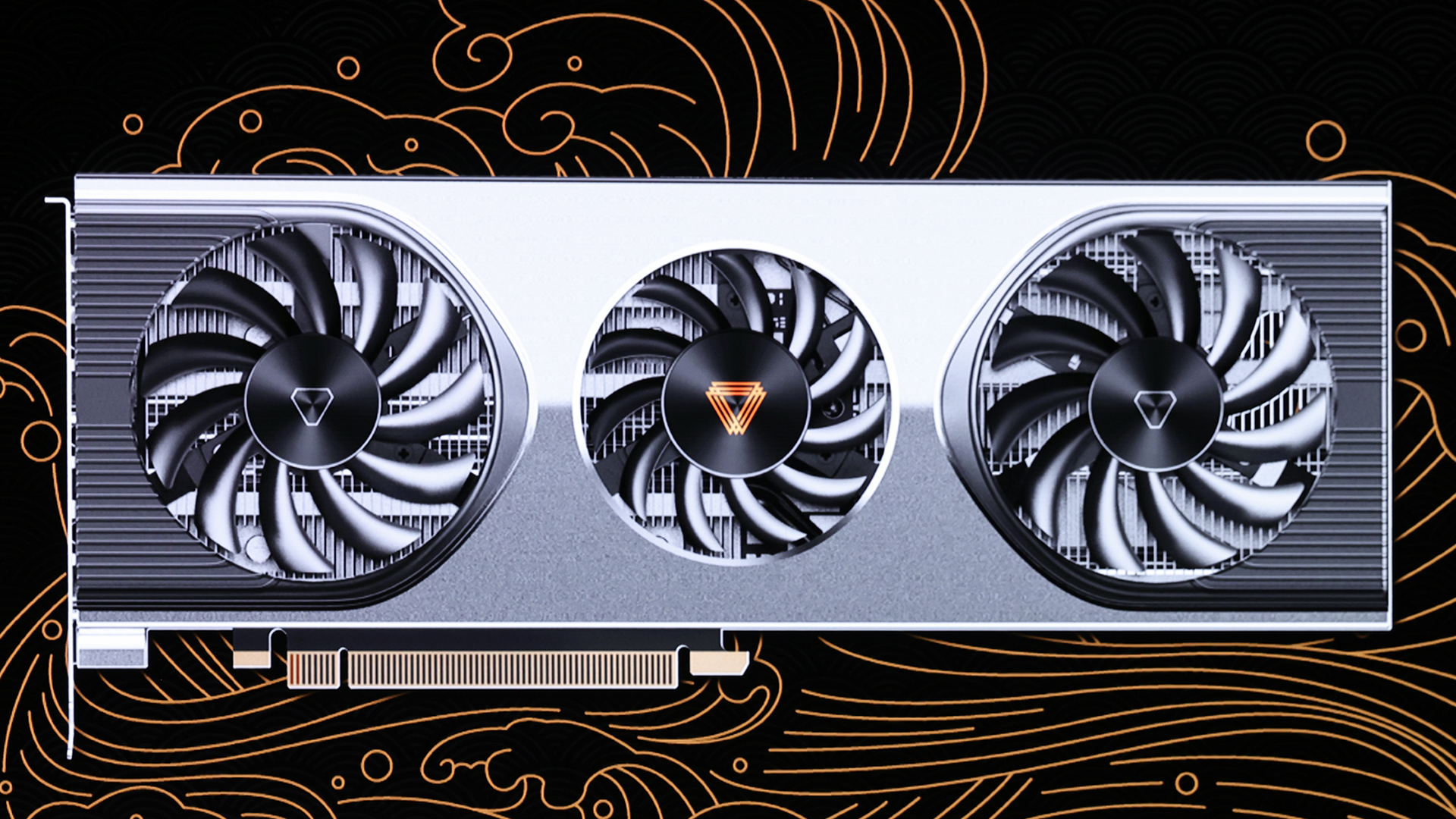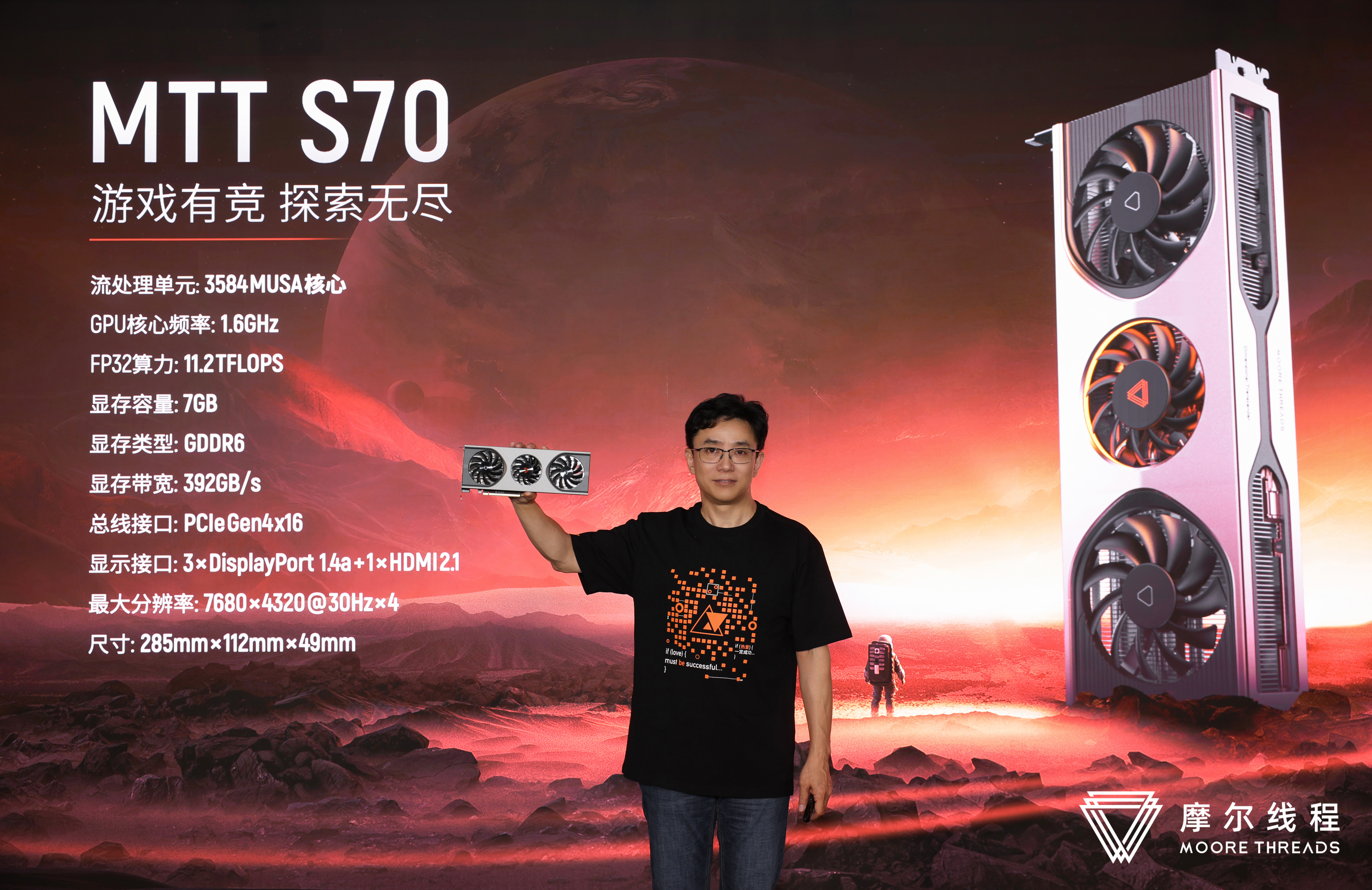Moore Threads MTT S70: A GPU with 7GB of GDDR6 Memory

Moore Threads has introduced its new midrange graphics card, the MTT S70, which is powered by a cut-down version of its Chunxiao graphics processor and is equipped with 7GB of GDDR6 memory. The product will offer FP32 compute throughput of a little bit lower than that of the GeForce RTX 3060 in boost mode, though its real-world performance is something that remains to be seen.
The Moore Threads MTT S70 is based on the Chunxiao GPU with 3584 stream processors that operates at 1.60 GHz (down from 4096 SPs at 1.80 GHz in case of the MTT S80) and offers FP32 compute performance of 11.2 TFLOPS, which is slightly below peak performance of Nvidia's GeForce RTX 3060 (12.74 TFLOPS). The board comes with a large cooling system and has three DisplayPort 1.4a and one HDMI 2.1 output, which is in line with the flagship MTT S80.
| null | MTT S70 | MTT S80 |
| Stream Processors | 3584 | 4096 |
| GPU frequency | 1.60 GHz | 1.80 GHz |
| Peak FP32 Throughput | 11.2 TFLOPS | 14.4 TFLOPS |
| Memory Capacity | 7GB | 16GB |
| Memory Interface | 224-bit | 256-bit |
| Memory Type | GDDR6 | 14 GT/s GDDR6 |
| Memory Bandwidth | 392 GB/s | 448 GB/s |
| Display Outputs | 3xDP 1.4a + HDMI 2.1 | 3xDP 1.4a + HDMI 2.1 |
The thing that catches the eye about the MTT S70, though, is its rather odd memory configuration: the board carries 7GB of memory with 392 GB/s bandwidth, which suggests that its memory interface was cut down to 224-bits. Apparently, Moore Threads also decided to reduce memory capacity rather significantly, so the board comes with 7GB of memory, which is not enough for many games by today's standards.
While compute performance and memory capacity are extremely important for overall performance of a GPU, things like overall architecture efficiency and drivers have a great influence on performance of a graphics card. Moore Threads's current flagship MTT S80 has FP32 throughput comparable to that of GeForce RTX 3060 Ti, but it not only failed to match GeForce RTX 3060 in games that its drivers support, but it also failed to outperform Nvidia's GeForce GT 1030 due to poor drivers.
In any case, at this point even the range-topping and rather powerful MTT S80 probably has no chances to join the ranks of the best graphics cards and so the MTT S70 is also unlikely to do this. Hopefully, Moore Threads fixes its drivers rather sooner than later. During the event the company demonstrated a slide detailing MTT S80's performance improvements from Q4 2022 to Q2 2023.

Just like other GPU designers, Moore Threads, a rising star of the Chinese semiconductor industry, uses cut-down versions of its flagship GPUs to address lower-end market segments. The MTT S70 received a rather significant cutdown, which will enable the GPU developer to ship a boatload of these graphics cards if there is enough demand.
Get Tom's Hardware's best news and in-depth reviews, straight to your inbox.

Anton Shilov is a contributing writer at Tom’s Hardware. Over the past couple of decades, he has covered everything from CPUs and GPUs to supercomputers and from modern process technologies and latest fab tools to high-tech industry trends.
-
Stesmi Not that weird, really.Reply
I haven't looked into the architecture, so I could be off base here, but look at the Stream Processors, 3584 vs 4096. If the arrangement is one memory channel per 512 Stream Processors, 512*7 = 3584 and 512*8 = 4096.
# 32-bit memory channelsMemory Interface widthStream Processors132-bit5126192-bit30727
224-bit35848256-bit4096
I'm guessing here, but it does seem plausible.
Another thing - Odd memories are back. The same thing was said when the first non-power-of-2 size came to the market, it was also odd, but now it's normal. Same goes here. -
InvalidError Replythe board comes with 7GB of memory, which is not enough for many games by today's standards.
That is mostly only true for pixel snobs who insist on playing everything at mostly maxed-out settings, which is rarely an option on what is probably a $200-ish GPU no matter how much VRAM you throw at it. -
bit_user Reply
Nice analysis, but I think there could be a simpler explanation. My guess is they had a bin full of dies where either one memory channel was bad or some bank of stream processors was bad. Instead of creating two different lower-tier products, they just put them all in the same bin and that's how they ended up at 7/8ths.Stesmi said:Not that weird, really.
I haven't looked into the architecture, so I could be off base here, but look at the Stream Processors, 3584 vs 4096. If the arrangement is one memory channel per 512 Stream Processors, 512*7 = 3584 and 512*8 = 4096.
Right. I mean, considering its current performance level, in actual games, you probably can't play anything on settings that require > 7 GB, anyway.InvalidError said:That is mostly only true for pixel snobs who insist on playing everything at mostly maxed-out settings, which is rarely an option on what is probably a $200-ish GPU no matter how much VRAM you throw at it.
Perhaps their next generation of products will start to be "interesting", at least from a value perspective. -
You forgot to mention one major change/downgrade done by MTT.Reply
The S70 only supports PCIe Gen4 x16 interface, unlike the S80 which ironically was the first GPU to get PCIe Gen5 support ~! :rolleyes:
edited for typo errors. -
Stesmi Reply
Oh yes, absolutely. They could be, but don't have to be connected. I was speculating. It would make economical sense to have an out, as you describe - one bank bad and/or one memory channel bad => S70.bit_user said:Nice analysis, but I think there could be a simpler explanation. My guess is they had a bin full of dies where either one memory channel was bad or some bank of stream processors was bad. Instead of creating two different lower-tier products, they just put them all in the same bin and that's how they ended up at 7/8ths. -
Stesmi Reply
I wonder if that's fused in hardware or not, as I would guess they are the same dies, just fused off parts. Nice catch.Metal Messiah. said:You forgot to mention one major change/downgrade by by MTT.
The S70 supports only supports PCIe Gen4 x16 interface, unlike the S80 which ironically was the first GPU to get PCIe Gen5 support ~! :rolleyes: -
bit_user Reply
They certainly said so, but then it's highly comical to read their various announcements prior to the launch of that GPU. I honestly wonder if it even worked at PCIe 5.0 speeds.Metal Messiah. said:the S80 which ironically was the first GPU to get PCIe Gen5 support ~!
I had a 1st gen PCIe 3.0 motherboard and GPU. For the longest time, it would often auto-negotiate down to PCIe 2.0. I never figured out why, but I didn't really care. -
Also this Chunxiao architecture platform lacks proper support for DX12, Vulkan or OpenGL programming interfaces, which severely holds this arch back, hence that's why the S80 only matches the performance of a GT 1030 ! Which is very less by today's standard.Reply
MTT needs to focus more on drivers, firmware and software to get full benefits from the S70/S80. -
Replybit_user said:They certainly said so, but then it's highly comical to read their various announcements prior to the launch of that GPU. I honestly wonder if it even worked at PCIe 5.0 speeds.
Technically speaking MTT was the first company to announce that the S80 supports full PCIe Gen5 x16 interface, but whether the card worked at it's full potential is highly doubtful. I don't think in real life benchmarks/apps the S80 really took full advantage of the PCIe Gen5 x16 interface.
Although it's a first PCIe 5.0 graphics card it is unlikely to leverage such bandwidth potential.
But hey, this card can at least play CRYSIS, so that's something for MTT to brag about ! (y) :D It appears that the "Can it play Crysis" meme lives on forever till eternity!
1R8dQWw7ldM:1View: https://www.youtube.com/watch?v=1R8dQWw7ldM&t=1s -
ReplyStesmi said:I wonder if that's fused in hardware or not, as I would guess they are the same dies, just fused off parts. Nice catch.
I think it might be fused on the hardware, unless they are using a totally new die for the S70..
